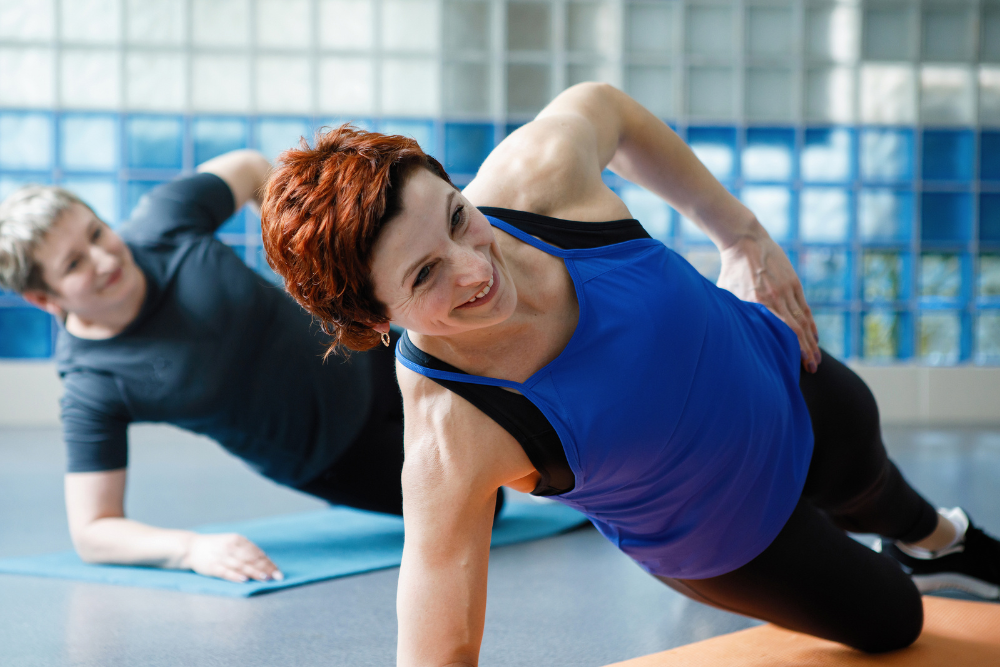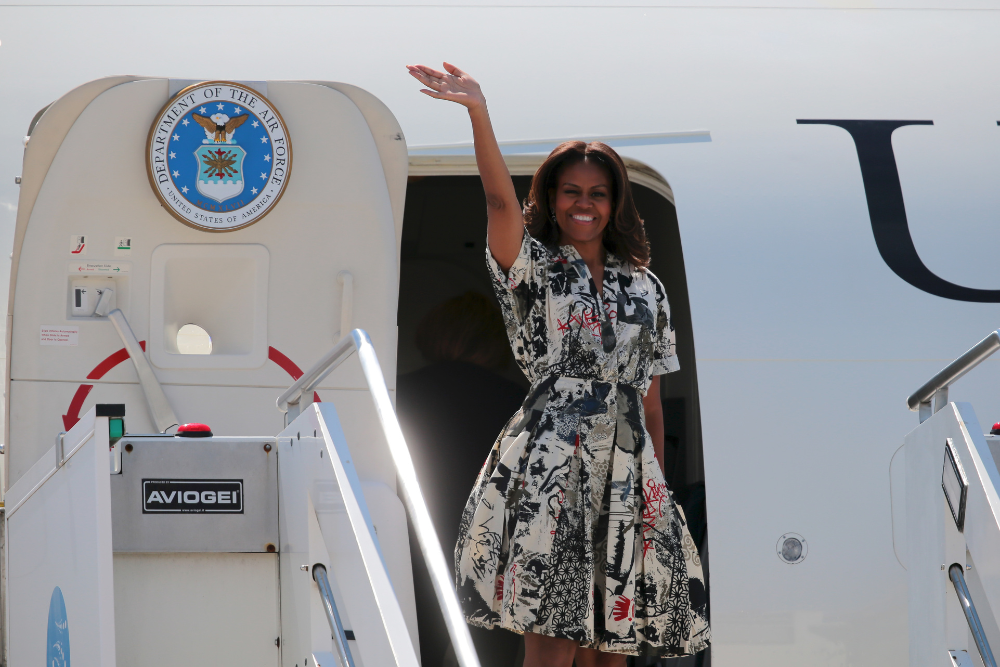Exercise After Menopause: What You Need To Know

Menopause is one of the most significant events in a woman’s life, and with it comes several changes that can affect function. Moreover, the post-menopausal period comes with many health considerations that can have a profound impact on one’s life.
However, it isn’t all doom and gloom.
See, many of the negative factors that occur after menopause can be mitigated by exercise – making it the most effecting post-menopausal health booster on the planet.
Health concerns after menopause
I have already indicated that several health concerns can arise after menopause – but what are they, and how do they impact you?
Osteoporosis
One of the most well-known post-menopause related health issues is osteoporosis. Bones mass normally peaks around the age of 30. Then, in the general population, people lose approximately 0.5% of their total bone mass per year – however, this accelerates rapidly after menopause.
In fact, in the first 20 years after menopause, there is on average a 50% reduction in trabecular bone and 30% reduction in cortical bone [1].
These rapid reductions are largely driven by the reductions in estrogen levels observed after menopause.
Cardiovascular and metabolic disease
In addition to its effect on bone health, lower estrogen levels have also been shown to lead to an increase in levels of low-density lipoprotein (also known as LDL, or “bad” cholesterol) found in the blood [2]. High levels of LDL are strongly associated with an increased risk of cardiovascular disease, which becomes increasingly prevalence in post-menopausal women compared to their pre-menopausal counterparts.
Additionally, the post-menopausal period is also associated with an increase in insulin resistance, which has been shown to contribute to a greater risk of developing type II diabetes and metabolic disease.
Depression
Many of the hormonal changes that occur during – and after – menopause can also have a significant impact on the brain.
Cross sectional studies have shown that women who have gone through menopause are at a much greater risk of developing depression compared to those who are yet to start going through menopause [3].
Moreover, longitudinal research on the topic has indicated that the onset of depressive symptoms are directly related to the menopausal transition [4], suggesting a causal link between menopause and declines in mental health.
Dementia and Alzheimer’s disease
It is well-established that post-menopausal women are at a much greater risk of developing Alzheimer’s disease and dementia than their younger counterparts [5]. While this is not due to menopause per se, and rather associated with increased age, it is something that deserves mention. Both key issues are extremely common and can severely impact an individual’s ability to function day-to-day.
Related Article: Exercise, Fitness, And Alzheimer’s Disease
Breast Cancer
After menopause, breast tissue is slowly replaced with adipose tissue. This is what drives age-related increase in breast density. Importantly, it is also thought to explain why breast cancer becomes more common with age in females, with women having a one in eight chance of getting breast cancer in their lifetime [6].
Functional ability and sarcopenia
Finally, we have sarcopenia and its associated changes in physical function. Sarcopenia is a condition typified by a loss of muscle mass, leading to reductions in muscle strength and muscle performance. During aging and the menopausal transition, there is often a significant reduction in muscle mass which is thought to be the primary cause of sarcopenia. This in turn leads to an increased likelihood of falls, fractures, physical disability, and even mortality, as well as reductions in quality of life and physical function [7].
The benefits of exercise after menopause
I certainly appreciate that looking through this it can start looking grim – but as I outlined in the introduction, there is a solution (and a simple one that).
Yep, you know it – exercise.
The benefits of Aerobic Exercise Post-Menopause
Aerobic exercise is one of the most accessible and scalable forms of exercise on the planet. Whether it be walking, running, swimming, rowing, cycling, or anything in between, it can be absolutely life changing [8].
There is strong evidence demonstrating that regular aerobic exercise can help reverse some of the changes in blood cholesterol that occur after menopause, which has a propound impact on risk of cardiovascular disease.
Moreover, there is a large body of research demonstrating that aerobic exercise can improve mood, promote sensations of well-being, and reduce signs and symptoms of depression and anxiety [9].
And lastly, choosing aerobic exercise that has an impact component, such as running and skipping, can also lead to increases in bone density, which aids in the prevention of post-menopausal osteoporosis.
The benefits of Strength Training Post-Menopause
When it comes to maximising health after menopause, weight training is integral [10, 11]. Weight training has been shone to have favourable effects on the health and function of muscle tissue, leading to increases in insulin sensitivity. By extension, it also has a protective effect on metabolic disease and type II diabetes.
Importantly, strength training has also been shown to increase muscle mass and strength in post-menopausal women. This can lead to reductions in sarcopenia, improved balance, a lower risk of falls, and improvements in functional ability.
If this weight training is performed somewhat heavy loads, it has also been shown to simulate the formation of new bone tissue, leading to increases in bone mineral density and a reduced risk of osteoporosis.
Finally, if this weight training implements core fundamental movements like squats, lunges, and deadlifts, it also has the capacity to improve balance and enhance your ability to perform tasks of daily living.
The benefits of Flexibility and Balance Training Post-Menopause
While there is no question that when it comes to exercise for post-menopausal health, aerobic and strength training should be your first point of call – however, flexibility and balance training, such as stretching and yoga, can also have a positive impact.
Stretching has been shown to reduce pain and improve upon measures of pain and dysfunction. Yoga has been shown to have extremely positive effects on mental health, while also increasing balance and functional ability [12, 13].
The benefits of Power Training Post-Menopause
Lastly, I wanted to touch on power training. While not as common as strength training, power training has also been shown to have considerable benefits in post-menopausal populations.
Power training improves your ability to produce force rapidly. This can lead to an improvement in balance and a reduction in risk of falls. Additionally, it also improves muscle strength and size, while the high degree of impact is extremely beneficial for increasing bone mineral density [14].
Related Article: Michelle Obama Has It Backwards: You Should Train Harder After Menopause
The benefits of Sprint and Speed Training Post-Menopause
Now, one of the most common forms of power training is sprinting and speed training. As its name aptly suggests, sprint training and speed training simply involves running at maximal or near-maximal intensities for shorter distances (i.e., at distances between 20 and 400 metres). If you can imagine the type of training a 100, 200, or 400 metres sprinter would do, this is it.
While sprint training is ultimately a type of power training, it does seem to have additional benefits that don’t come with pure per training.
Firstly, sprint interval training has been shown to have positive effects on body composition, aerobic fitness, and cardiometabolic factors, suggesting that it will not only change thew way you look and feel but also prevent your risk of diabetes and cardiovascular disease [15, 16]. Additionally, sprint and speed training has been shown to have a profound effect on bone mineral density, making it one of the most effective means of preventing osteoporosis [17].
In short, it should be a part of your program if you comfortable doing it.
Exercise Considerations Post-Menopause
When it comes to implementing exercise after menopause, there are some things that should be considered. Firstly, you should base your starting point on your current capabilities. You don’t have to dive headfirst with intense CrossFit workouts. Your strength training regime can commence with some low-level bodyweight exercise performed at home, and your aerobic exercise can be a couple of easy walks per week.
Then, as your fitness increases, you can increase the intensity of your sessions accordingly.
Secondly, you should strive to meet the recommended physical activity guidelines. This means aiming for more than 150 minutes of aerobic exercise per week, and at least two muscle strengthening exercise sessions per week (this means strength, power, or sprint training). You can then sprinkle any balance and flexibility training around this.
Again, you don’t have to start here – but this should be the target.
Lastly, don’t be afraid to see a professional. Starting an exercise regime can be one of best things you can do for your body – but it can also be scary. So don’t be afraid to reach out to an exercise professional for advice and guidance when required.
Final Comments
Post-menopause is associated with a number of health risks – however, many of these can be mitigated by exercise.
By following the tips in this article, you can start your exercise journey and maximise your health after menopause, rather than watch it decline. And remember, it is never too late to start!
You Might Like:
Upper Body Strength in Post-Menopausal Women
Menopause is a unique time in the human life, and with it comes a myriad...Exercise After Menopause: What You Need To Know
Menopause is one of the most significant events in a woman’s life, and with it...Michelle Obama Has It Backwards: You Should Train Harder After Menopause
A recent interview with Michelle Obama that was published on HarpersBazar.com has been doing the...Does Testosterone Boost Athletic Performance in Female Athletes?
Testosterone is one of the most talked about hormones in the human body – especially...Menopause and Depression
Hunter Bennett Menopause is considered to be a time of great change. A time where...Menopause and Sleep
Hunter Bennett Menopause is commonly considered to be one of the most trying times in...References:
Roeca, Cassandra, Zain Al-Safi, and Nanette Santoro. “The postmenopausal women.” Endotext [Internet] (2018).
Woodard, Genevieve A., et al. “Lipids, menopause and early atherosclerosis in swan heart women: menopausal transition and lipids.” Menopause (New York, NY) 18.4 (2011): 376.
Bromberger, Joyce T. “The menopausal transition increases the risk of depressive symptoms and depression diagnosis in women without a history of depression.” Evidence-based mental health 9.4 (2006): 110.
Cohen, Lee S., et al. “Risk for new onset of depression during the menopausal transition: the Harvard study of moods and cycles.” Archives of general psychiatry 63.4 (2006): 385-390.
Jamshed, Nayer, et al. “Alzheimer disease in post-menopausal women: Intervene in the critical window period.” Journal of mid-life health 5.1 (2014): 38.
Sakorafas, George H., Eustathios Krespis, and George Pavlakis. “Risk estimation for breast cancer development; a clinical perspective.” Surgical Oncology 10.4 (2002): 183-192.
Buckinx, Fanny, and Mylène Aubertin-Leheudre. “Sarcopenia in menopausal women: current perspectives.” International Journal of Women’s Health 14 (2022): 805.
Grindler, Natalia M., and Nanette F. Santoro. “Menopause and exercise.” Menopause 22.12 (2015): 1351-1358.
Stojanovska, Lily, et al. “To exercise, or, not to exercise, during menopause and beyond.” Maturitas 77.4 (2014): 318-323.
Leite, R. D., et al. “Menopause: highlighting the effects of resistance training.” International journal of sports medicine 31.11 (2010): 761-767.
Orsatti, Fábio Lera, et al. “Heterogeneity in resistance training-induced muscle strength responses is associated with training frequency and insulin resistance in postmenopausal women.” Experimental Gerontology 163 (2022): 111807.
Li, Wei-Chun, et al. “Effects of exercise programmes on quality of life in osteoporotic and osteopenic postmenopausal women: a systematic review and meta-analysis.” Clinical rehabilitation 23.10 (2009): 888-896.
References:
Shepherd-Banigan, M., et al. “Improving vasomotor symptoms; psychological symptoms; and health-related quality of life in peri-or post-menopausal women through yoga: An umbrella systematic review and meta-analysis.” Complementary therapies in medicine 34 (2017): 156-164.
Stengel, S. Von, et al. “Power training is more effective than strength training for maintaining bone mineral density in postmenopausal women.” Journal of applied physiology (2005).
Ho, Tze Y., et al. “The effect of interval sprinting exercise on vascular function and aerobic fitness of post‐menopausal women.” Scandinavian Journal of Medicine & Science in Sports 30.2 (2020): 312-321.
Boutcher, Yati N., et al. “The effect of sprint interval training on body composition of postmenopausal women.” Medicine & Science in Sports & Exercise 51.7 (2019): 1413-1419.
Ireland, Alex, et al. “Greater maintenance of bone mineral content in male than female athletes and in sprinting and jumping than endurance athletes: a longitudinal study of bone strength in elite masters athletes.” Archives of osteoporosis 15.1 (2020): 1-10.

















